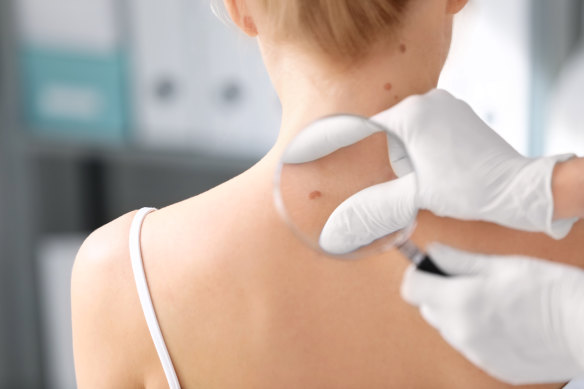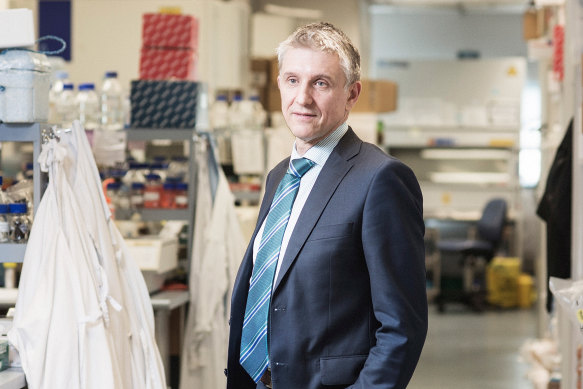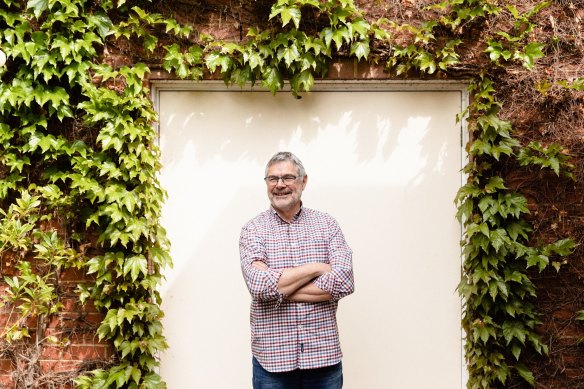By Aisha Dow
Thousands of Victorians are unknowingly living with cancer after diagnoses of the disease fell far below expected levels during the first two years of the pandemic.
A report by the Victorian Cancer Registry, published on Thursday, estimates that 4.3 per cent fewer cases were detected in 2021 than would be expected based on historical trends.

Hundreds of melanoma cases are being missed in Victoria.Credit: File Image
Researchers were hoping to see an above-normal number of detections, to catch up on a shortfall in 2020 when cancer diagnoses were 7 per cent below what would ordinarily be expected.
Victorian Cancer Registry director Professor Sue Evans described the findings as “disappointing” and “sobering”.
“We have still got lots of Victorians walking around undiagnosed with a cancer,” she said. “It’s important that we get to cancers early because [when we do] there is certainly a better prognosis.”
There are fears the trend could persist well beyond the early years of the pandemic, as people are visiting their GPs less, using telehealth services more and skipping routine cancer screening.

Professor Grant McArthur from the Victorian Comprehensive Cancer Centre Alliance.Credit: Josh Robenstone
Victorian Comprehensive Cancer Centre Alliance executive director Professor Grant McArthur said people had changed their behaviours and their habits. “This seems to be persisting, which is of concern.”
McArthur said it was important people kept up to date with skin, bowel, breast and cervical cancer screening “because those programs save lives and reduce the impact of cancer very substantially”.
The new data estimates there are 3864 Victorians living with cancers that would otherwise have been discovered in 2020 and 2021 if it wasn’t for the impacts of the pandemic and extended lockdowns.
There is an estimated diagnosis shortfall of 846 bowel cancer cases, 827 melanoma cases, 644 blood cancer cases, 395 breast cancer cases and 254 lung cancer cases.
In a welcome finding of the report, for the first time, five-year cancer survival rates among Victorians surpassed 70 per cent of patients.
But the picture varies markedly between types of cancer. Thyroid cancer and melanoma cancer patients have five-year survival rates beyond 90 per cent, while only 13 per cent of pancreatic cancer patients and 9 per cent of mesothelioma patients survive past five years.
Regional Victorians are 9 per cent more likely to be diagnosed with cancer than city dwellers, and for melanoma the risk is 44 per cent higher in the regions.
Evans said this could be partly explained by the older average age of people who live regionally.

Leigh Rowe was able to catch his cancer early.Credit: Bri Hammond
Melbourne retiree Leigh Rowe is an example of the importance of regular cancer screening, especially for those more at risk of certain types.
The 67-year-old has a family history of prostate cancer and, while he was still working, used to get regular tests for the disease. But he had become less vigilant since he retired.
“A lot of blokes think it won’t happen to them,” he said.
His GP suggested he get tested, and the results were worrying enough to send Rowe to a urologist, who ordered a precautionary MRI scan. The test showed two tumours in the prostate.
“It was not a super-bad cancer, but not benign enough to ignore,” said Rowe.
He had surgery to remove the tumours and, while he has experienced some side effects, his latest test came back clear.
He said he was grateful to be alive and planning trips to Antarctica, South America and Europe.
“You never really think it’s going to happen to you. One day maybe, but not today. All of a sudden, it’s today.”
The Morning Edition newsletter is our guide to the day’s most important and interesting stories, analysis and insights. Sign up here.